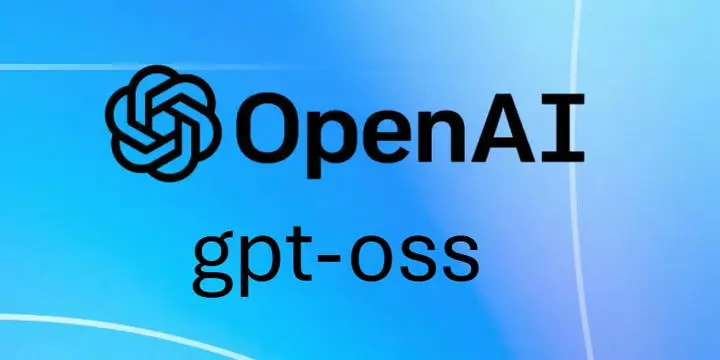OpenAI has officially entered the open-weight AI race with the release of GPT‑OSS, its first freely downloadable models since GPT‑2 back in 2019. This marks a dramatic shift for the company, which has until now kept its best models locked behind APIs.
The new models—gpt‑oss‑120b and gpt‑oss‑20b—are designed to offer high performance, full transparency, and flexible deployment, meeting the needs of both developers and enterprises who want full control over their AI systems.

What Is GPT‑OSS?
GPT‑OSS is OpenAI’s first open-weight model family featuring:
- gpt‑oss‑120b – A 117B parameter Mixture-of-Experts (MoE) model using ~5.1B active parameters per token.
- gpt‑oss‑20b – A 21B parameter MoE model using ~3.6B active parameters per token.
Both models are trained with instruction-following, chain-of-thought reasoning, and tool-use capabilities, making them viable alternatives to closed systems like GPT-3.5 and even GPT-4-mini in some use cases.
Why This Release Matters
1. Open-Weight, Apache 2.0 Licensed
The models are released under an Apache 2.0 license, enabling:
- Commercial use
- Academic research
- Full customization
- Redistribution without royalties
This makes GPT‑OSS ideal for building proprietary assistants, private agents, or deploying in regulated industries.
2. Competitive Benchmarking
- gpt‑oss‑120b rivals OpenAI’s o4‑mini in reasoning benchmarks.
- gpt‑oss‑20b matches o3‑mini, offering strong performance on mid-tier tasks.
Benchmarks include MMLU, GPQA, Big-Bench, CodeBench, and Toolformer-style evaluations, confirming the models’ ability to handle reasoning, retrieval, code, math, and agentic workflows.
3. Broad Deployment Options
You can run GPT‑OSS across:
- Cloud: AWS SageMaker JumpStart, Azure AI Foundry, Databricks
- On-Prem or Edge: Llama.cpp, Ollama, LM Studio
- On-Device: gpt‑oss‑20b can run on devices with ~16GB VRAM
This flexibility allows developers to self-host models without vendor lock-in—crucial for industries focused on data privacy and infrastructure control.
Key Technical Features
Mixture-of-Experts (MoE) Architecture
Unlike dense models, GPT‑OSS uses MoE routing, where only a few “expert” subnetworks activate per input. This allows:
- Smaller compute loads
- Faster inference
- Efficient use of larger models on available hardware
Quantization-Ready
Both models are available in 4-bit quantized formats (mxfp4), reducing memory and compute requirements while preserving high reasoning quality.
Instruction-Following & Tool Use
Out-of-the-box support for:
- Chain-of-Thought prompting
- Structured JSON outputs
- Function-calling / API triggering
- RAG workflows and agentic use cases
These features make GPT‑OSS capable of powering AI chatbots, dev agents, code assistants, and more.
How to Get Started
For Local Deployment (gpt‑oss‑20b)
- Install Llama.cpp or Ollama
- Download model weights from Hugging Face
- Run with:
./main -m gpt-oss-20b.bin --prompt "What is the difference between AGI and LLMs?"
For Enterprise Deployment (gpt‑oss‑120b)
- Use AWS SageMaker JumpStart or Azure AI Foundry
- Supports private endpoints with EXA web search integration
- Add role-based governance and safety controls via Databricks Unity Catalog
Real-World Use Cases
| Use Case | Model | Platform |
|---|---|---|
| Local AI Assistant | gpt‑oss‑20b | LM Studio / Ollama |
| RAG + Web Search | gpt‑oss‑120b | SageMaker + EXA |
| Enterprise Agent | gpt‑oss‑120b | Databricks / Azure |
| Code Assistant | gpt‑oss‑20b | Llama.cpp |
These models are ideal for regulated industries, data-sensitive environments, and custom domain AI agents.
OpenAI’s Shift Toward Open Ecosystems
This release signals a broader strategic shift:
- Rebuilding trust with open science advocates
- Reducing dependence on APIs and rate limits
- Competing directly with Meta’s Llama 3 and Mistral’s Mixtral
According to OpenAI’s model card, GPT‑OSS passed safety audits, including adversarial fine-tuning tests, confirming the models don’t exhibit emergent high-risk behavior in their base form.
GPT‑OSS is OpenAI’s biggest open-source move since GPT‑2, and it changes the landscape of accessible AI development.
Whether you’re a solo developer looking to build a local assistant or a company needing full control over AI reasoning in sensitive workflows, GPT‑OSS gives you:
- Full access to powerful LLMs
- Freedom to deploy on your terms
- Confidence through transparent safety design
With no API limits, no vendor lock-in, and Apache 2.0 licensing, GPT‑OSS is set to become a serious contender in the open-weight model space.
FAQs About GPT‑OSS
Q: Is GPT‑OSS open-source?
Yes. It’s released under Apache 2.0, allowing commercial and research use.
Q: Can I run it on a laptop?
Yes. The 20B model runs on ~16GB VRAM systems using Ollama or LM Studio.
Q: How does performance compare to GPT‑4?
gpt‑oss‑120b is not as strong as GPT‑4, but comparable to GPT-4 mini (o4‑mini), especially in reasoning and tool use.
Q: Are there safety concerns?
OpenAI has tested for misuse risks. The models ship below known danger thresholds, but you’re responsible for monitoring deployments.
Q: Where can I download the models?
From Hugging Face: openai/gpt‑oss‑20b and openai/gpt‑oss‑120b









